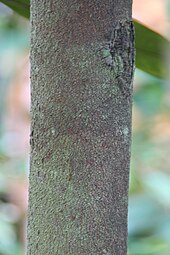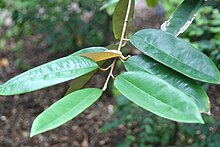Durio graveolens
| Durio graveolens | |
|---|---|

| |
| Durio graveolens 'Suluy Z' at Fairchild Tropical Botanic Garden, Miami | |
| Scientific classification | |
| Kingdom: | Plantae |
| Clade: | Tracheophytes |
| Clade: | Angiosperms |
| Clade: | Eudicots |
| Clade: | Rosids |
| Order: | Malvales |
| Family: | Malvaceae |
| Genus: | Durio |
| Species: | D. graveolens
|
| Binomial name | |
| Durio graveolens | |
 Fruit and leaves of D. graveolens | |
| Nutritional value per 100 g | |
|---|---|
| Energy | 152 kcal (640 kJ) |
| Dietary fiber | 21.5 g |
6.2 g | |
| Saturated | 1.9 g |
| Trans | 0.9 g |
| Monounsaturated | 2.5 g |
| Polyunsaturated | 1.8 g 1.8 g |
2.6 g | |
| Vitamins | Quantity %DV† |
| Vitamin C | 12% 10.4 mg |
Copper | 78% 0.7 mg |
| Iron | 3% 0.6 mg |
| Magnesium | 6% 27 mg |
| Manganese | 17% 0.4 mg |
| Phosphorus | 3% 43 mg |
| Potassium | 18% 529 mg |
| Zinc | 5% 0.59 mg |
| Other constituents | Quantity |
| Water | 66.7% |
| Cholesterol | 0 mg |
| †Percentages estimated using US recommendations for adults,[5] except for potassium, which is estimated based on expert recommendation from the National Academies.[6] Source: (Hoe & Siong 1999)[3] (Nasaruddin, Noor, & Mamat 2013)[4] | |
Durio graveolens, sometimes called the red-fleshed durian,
D. graveolens is an edible durian,
Names
This species should not be confused with the popular durian clones from Malaysia known as 'Red Flesh' (D164) and 'Red Prawn' (D175), as both of those belong to D. zibethinus.[17]
However, D. graveolens does have one registered variety, 'DQ2 nyekak (DK8)'.[17] The color of the fruit's flesh denotes other varieties–an orange-fleshed, a red-fleshed one, and yellow-fleshed. These varieties may be different species, but currently there is no consensus.[12][16] The yellow-fleshed kind is sometimes called durian simpor.[12][8][7]
In the scientific name Durio graveolens,
In Malay, the fruit is called durian burong, durian burung[7] (literally "bird durian"), durian rimba ("jungle durian"),[15] durian kuning[7][19][12] ("yellow durian"),[4] durian merah ("red durian"),[7][16][12][14] or durian otak udang galah[19][12] ("crayfish brain durian").[8] In Iban, it is durian isu.[8] The Bidayuh call it durian umot.[8] Among the Kenyah and Dayak peoples, it is known as durian anggang ("hornbill durian"),[15] durian ajan, pesang,[15] tabela or ta-bela,[15] tabelak,[12][7] taula,[15][12] tuala, tuwala.[8] On Sumatra, the Batak call it tinambela.[15][12][8] In Karo, it is called meraan.[20] In Thailand, it is referred to as thurian rak kha (Thai: ทุเรียนรากขา) or thurian khua tit (ทุเรียนขั้วติด; sources differ on which name refers to this species, with the other being attributed to D. kutejensis).[21][22] In Aceh Tamiang Regency, it can be called durian batu ("stone durian"), and elsewhere in Sumatra, it known as durian adjan.[15][12] Other regional names include durian dalit[16][12][23] (but this can apply also to Durio oxleyanus[24]) alau, dujen, durian alau, durian daun dungoh, durian hutan[12] ("forest durian"), durian pipit, lai bengang, merang kunyit, pasang, and tongkai.[8]
A natural hybrid of D. graveolens and D. zibethinus is called durian siunggong or durian suluk.[7][8][12] It has the texture and flavour of the popular D. zibethinus and the burnt caramel overtones of D. graveolens.[8][7]
After its initial description in 1889 by
Distribution
Wild D. graveolens grows in Peninsular Malaysia[8][15][7][14] (states of Johor, Kedah, Kelantan, Malacca, Penang, Perak, Selangor, and Terengganu), Indonesian Islands of Borneo[8][15][7][14] and Sumatra,[15][14][7][8] Palawan,[7] and Southern Thailand.[26] It is cultivated in Brunei,[7] Sarawak, Sabah,[8] and the Northern Territory of Australia.[14] In Brunei, its popularity outshines D. zibethinus,[19] which is not cultivated in the country.[27]
It is occasionally grown outside the tropics. In Florida, it has been seen to survive two consecutive nights at 0 °C (32 °F), albeit shrouded in cloth.[28]
Description

D. graveolens is a large tree, sharing many features with D. dulcis.[2] It inhabits the upper canopy, growing up to 50 m (160 ft) tall.[8][15] The trunk is 85–100 cm (33–39 in) in diameter and can have no branches until about 25 m (82 ft) high.[8] The trunk will be smooth or flaky, grey/mauve to ruddy brown with steep buttress roots.[8] The buttresses reach 3 m (9.8 ft) and extend out 1.5 m (4 ft 11 in).[15]

The oblong leaves are 10–26 cm (3.9–10.2 in) long without the
Flowers grow on the branches
The fruits are up to 10–15 cm (3.9–5.9 in) in diameter,
Taxonomy
D. graveolens is in the core clade
Ecology

D. graveolens is a tropical plant species that needs high heat and humidity.
It is
After harvest, fruit can be set upon by fungi such as
The fruit is fed on by Bornean orangutans (Pongo pygmaeus),[20] Prevost's squirrels (Callosciurus prevostii), crab-eating macaques (Macaca fascicularis), black hornbills (Anthracoceros malayanus), possibly viverrids[31] and sun bears (Helarctos malayanus).[36] Black hornbills are also effective seed dispersers for the tree,[31] and this is referenced in a few of the regional names for the tree .
Biochemistry
The
Uses
The fruit's pulp is typically eaten raw and has the fragrance of roasted almonds
The seeds can also be ground into flour (tepung biji durian dalit), which then can be used to make, for example, fish crackers.[23]
The tree is also harvested for lumber in Sarawak.
See also
- List of Durio species
- Durian Burung, a town in Malaysia
References
- ^ "Durio graveolens". IUCN Red List. 6 February 2020. Retrieved 25 February 2022.
- ^ OCLC 880509632. Retrieved 29 October 2017.
- (PDF) from the original on 15 August 2017. Retrieved 3 November 2017.
- ^ (PDF) from the original on 1 December 2017. Retrieved 28 November 2017.
- ^ United States Food and Drug Administration (2024). "Daily Value on the Nutrition and Supplement Facts Labels". Retrieved 2024-03-28.
- )
- ^ ISBN 978-1-86320-405-7. Archived from the original(PDF) on 2018-02-19. Retrieved 2017-11-10.
- ^ S2CID 253915304.
- ^ "Durio graveolens". NCBI taxonomy. Bethesda, MD: National Center for Biotechnology Information. Archived from the original on 14 May 2018. Retrieved 26 October 2017.
Lineage( full ) cellular organisms; Eukaryota; Viridiplantae; Streptophyta; Streptophytina; Embryophyta; Tracheophyta; Euphyllophyta; Spermatophyta; Magnoliophyta; Mesangiospermae; eudicotyledons; Gunneridae; Pentapetalae; rosids; malvids; Malvales; Malvaceae; Helicteroideae; Durio
- ^ "Durio". The Plant List. 1.1. England. 23 March 2012. Archived from the original on 5 September 2017. Retrieved 9 November 2017.
- ^ a b Griffith, Chuck (2005). "Dictionary of Botanical Epithets". Dictionary of Botanical Epithets. Archived from the original on 19 September 2017. Retrieved 27 October 2017.
graveolens graveolens graveolens strong smelling graveolens graveolent adj strong smelling; rank Ruta graveolens L.
- ^ a b c d e f g h i j k l m n o Gasik, Lindsay (May 2013). "Durio graveolens". Year of the Durian. yearofthedurian.com. Archived from the original on 14 October 2017. Retrieved 4 November 2017.
- ^ ISBN 9780894991868. Retrieved 10 October 2019.
- ^ )
- ^ OCLC 4142407. Archived from the original on 2 December 2017. Retrieved 10 November 2017.)
{{cite journal}}: CS1 maint: DOI inactive as of January 2024 (link - ^ a b c d e "Wild durians of Borneo". Daily Express. Kota Kinabalu, Malaysia: Sabah Publishing House Sdn. Bhd. 5 February 2012. Archived from the original on 1 December 2017. Retrieved 5 November 2017.
- ^ a b "Varieties Registered For National Crop List". Plant Variety Protection Malaysia. Kuala Lumpur, Malaysia: Department of Agriculture, Malaysia. pp. 15–6, 52. Archived from the original on 1 December 2017. Retrieved 2 November 2017.
D164 Durian Durio zibethinus Linn. D175 Durian Durio zibethinus Linn. DQ2 Durian Sarawak Durio graveolens Becc Nyekak (DK8)
- ^ Lewis, Charlton T.; Short, Charles (1879). A Latin Dictionary. Oxford: Clarendon Press. Archived from the original on 10 October 2019. Retrieved 10 October 2019.
- ^ S2CID 37024997.
- ^ ISSN 0003-3472.
- ^ "ชื่อพรรณไม้ เต็ม สมิตินันทน์". Forest Herbarium (in Thai). Department of National Parks, Wildlife and Plant Conservation. Retrieved 14 May 2020.
- ^ Songpol Somsri (1999). "Interspecific Hybridization of Durian". Thai Agricultural Research Journal (in Thai). 17 (3): 294–302.
- ^ OCLC 973237888.
- ^ Ng, Murphy (19 December 2012). "Red and Orange Durians of Sabah". MySabah.com. Sabah, Malaysia. Archived from the original on 7 February 2018. Retrieved 29 November 2017.
Durian Dalit (Orange-flesh Durian), Species: Durio oxleyanus The husk of Durian Dalit is green color, with long and thick thorns outside. Durian Sukang (Red-flesh Durian), Species: Durio graveolens When ripe, the husk of Durian Sukang turns yellow, with short and sharp spines.
- ^ OCLC 38754437. Retrieved 11 November 2017.
- ^ "Durio graveolens Beccari, 1889". Catalogue of Life. Species 2000: Leiden, the Netherlands. Retrieved 29 September 2017.
- from the original on 2008-09-30. Retrieved 10 November 2017.
In Brunei Darussalam, D. zibethinus does not occur locally. The people in Brunei prefer the other species, such as D. graveolens, D. kutejensis and D. oxyleyanus. These species are quite commonly distributed in the country and together with other species like D. testudinarium and D. dulcis, represent rich genetic diversity.
- OCLC 22610361.
- ^ OCLC 199110722.
- ^ S2CID 42391364.
- ^ S2CID 82212472.
- PMID 10948003.
Wet masses of fruits recorded in Lambir Hills National Park were as follows: D. graveolens, 757. 5 g;... (T. Yumoto, unpublished data)
- OCLC 956468165. Retrieved 12 November 2017.)
Four hybrid seedlings were obtained in the crosses between D. zibethinus and D. graveolens, whereas no fruit set was observed in the crosses between D. zibethinus and D. oxleyanus, and between D. oxleyanus and D. graveolens.
{{cite book}}:|journal=ignored (help - from the original on 31 December 2018. Retrieved 12 November 2017.
- OCLC 476102040.
- (PDF) from the original on 19 February 2019. Retrieved 14 December 2018.
Durio graveolens Bombacaceae S fr Tree
External links
 Media related to Durio graveolens at Wikimedia Commons
Media related to Durio graveolens at Wikimedia Commons Data related to Durio graveolens at Wikispecies
Data related to Durio graveolens at Wikispecies- Durio graveolens at Year of the Durian
- Durio graveolens at Dr. Duke's Phytochemical and Ethnobotanical databases Archived 2022-12-09 at the Wayback Machine


